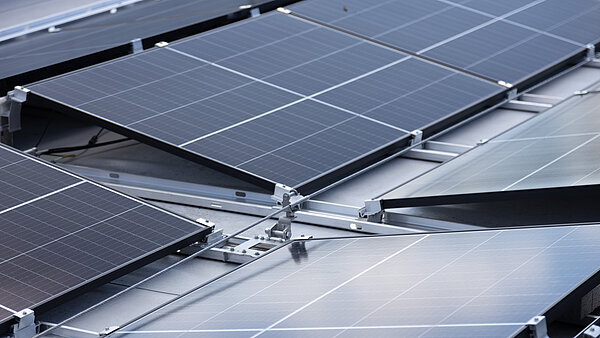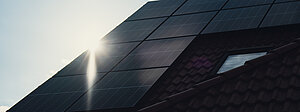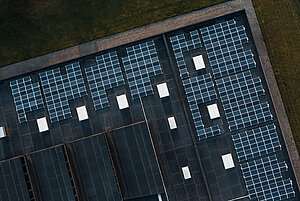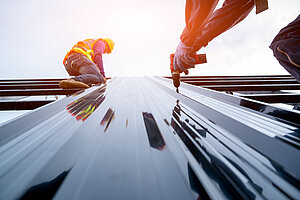Danger areas for PV systems on roofs, and why a fall prevention system is absolutely essential
You’ve landed a big order, and you’re looking forward to installing a PV system on an industrial roof. Everything’s going to plan and the first installation activities are taking place in sunny weather. You’re well on track and you’ve thought of almost everything, but then something avoidable happens. A fall occurs at the workplace on the roof, and therefore on the photovoltaic system, and so your employee is on sick leave. A worst case scenario that could have been avoided. You as a solar system installer clearly know that the roof has rapidly become a usable area, and the installation of photovoltaic systems on flat and pitched roofs has largely become routine for you.
However, accessing the roof area also harbours dangerous situations which must not be overlooked when the maximum safety of those working on the roof is to be ensured. A fall from a height of 2 to 3 metres generally has grave consequences and, as already explained, is accompanied by the employee being off work.
It is all the more important from the very start to consider the danger areas around the PV installation on the roof, and also to develop a safety concept, so that the installation and subsequent servicing and maintenance tasks are made as safe as possible. In that way, you as a solar system installer have the best possible protection in terms of fall protection.
An overview of the top 4 potential dangers
We first point out the major danger areas on a roof, and therefore on the photovoltaic system, and we explain why fall protection systems are absolutely essential.
- The fall edge
At the edge of a flat roof, the people working there walk a fine line between safety and danger. This is where tumbling, tripping caused by wet or similar can bring about a fall, because this is the actual location of the fall edge! But such a danger area can arise even in the middle of the roof and is generally caused by skylights. For this reason, an appropriate safety solution must provide optimal, reliable fall protection along this fall edge.
- Fall-through
Fibre-cement panels, translucent plastic panels, glass roofs, or even skylights and general roof openings – these are the locations of increased potential danger from fall-through. Particularly the risk of the illusion of safety often exists, with all its consequences. It is extremely important to record this potential danger at the very outset within the risk assessment, and then, after creating a safety concept, to install fall protection equipment.
Tip: You can discover everything worth knowing about falling through skylights on our application page “Skylights - fall-through protection with our individually adaptable systems”.
- Accesses/transitions
The route to the flat or pitched roof also has its pitfalls, because this access is often achieved via ladders or roof hatches/windows. Experience indicates that this vertical ascent via ladders is often neglected. Permanently anchored and secured accesses, or even permanently installed stepladders with guardrails, are rare in practice. In addition, it is rare that a solar technician, fitter, etc. has both hands free for moving “safely” along or down a roof.
Particular danger exists precisely between the transition from the roof hatch/window to the pitched roof, because this is exactly when the worker transits from the secured to the unsecured area. This is why fall protection systems are needed which continuously and reliably protect ascent and descent. Particular attention is required for transitions because, for example, the area between the ladder and the roof is one of the points of great potential danger. Depending on the actual situation, anchor points, rail systems, and also collective protection solutions can be implemented.
- The inclination of the roof itself
Pitched roofs have an inclination of at least 22° (in Switzerland at least 10°). For those present on these roofs and on the PV systems to perform installation, servicing, or maintenance tasks, there is a continuous risk of slipping and sliding. The effects of weather such as snow or rain make this even worse. In addition, this area can be secured only by means of what are called individual solutions, but more about this later.
Tip: Discover our new “Pitched roof” area on the website. This is where we summarise for you all the information about the challenges and benefits of a fall protection system.
“Remember all the danger areas for PV systems on roofs, in order to prevent falls effectively.”
On the roof and on the PV system
As a solar system installer, you want to generate the maximum solar power from the photovoltaic system installed on the flat or pitched roof. To achieve this, it is not unusual that the roof surfaces is laid with PV modules right up to the edge. However, this creates the problem that very little space is left for activities on the roof, like cleaning or servicing the equipment. As explained for the “Fall edge” potential danger, the respective workers are positioned directly adjacent to the roof edge or next to skylights, and are therefore immediately in the fall risk area.
This problem is made even more acute on a pitched roof, because of the roof’s inclination. In such cases, to protect against falls you should particularly ensure that professional, certified fall protection solutions are installed. This is the only way you can ensure that the PV equipment can be easily and safely accessed everywhere.
The question of liability - who is responsible for industrial accidents on the PV system on a roof?
The time has come - the PV system is being or already has been installed on the roof, and now it needs to be serviced or cleaned. The workers are ascending and descending to and from the roof, and are therefore in the fall-risk area. Mandatory regulations and standards apply to the roof area and to the safety of those people working there. The responsibilities in the event of an industrial accident are governed by law, and generally reside with the PV system operator. But as a solar system installer, you too are responsible for your employees during the installation of the PV system.
This person is liable for the resulting damages if an industrial accident such as a fall occurs. In addition, the factor of negligence is considered closely. This may also result in severe penalties. As a solar system installer, you should include safety and fall protection in your planning from the very start, i.e. before the installation of the photovoltaic system. You should also inform your clients about potential risks relating to PV systems on a roof.
The practical aspect
If the duration of installing a PV system on a roof exceeds 5 working days, the implementation site must be reported to the AUVA or to the Labour Inspectorate. In other words, you as a solar system installer and employer, and also the client, are responsible here for the safety of the employees on the roof. However, in every case you should rely on certified, professional fall protection systems, because you as the solar system installer must bear the responsibility jointly if, during an inspection or in the event of a fall, the fall protection system is determined to be defective or not even certified.
You, as the solar system installer, and the client too are responsible for the assessment of the danger areas. You must take appropriate precautions to protect your employees. And it can get even worse. If a certified fall protection system is mandatory but is not present on the construction site, the site can even be closed by the Labour Inspector, and access to the roof area may be banned.
With regard to securing PV systems on roofs, comply with country- and state-specific requirements. Read here about the situation in Switzerland.
Digression - statutory provisions
Never allow any activities to be performed without sufficiently planning a safety concept for installing the PV system. In §3 of the Austrian act on protection of workers of employers, it is mandatory that, regarding the dangers which exist, the employer must inform himself about the latest state of technology and how work is structured. In Germany too, the Occupational Safety Act (ArbSchG) prescribes that the employer must take necessary precautions for industrial safety, and that these must also be complied with by those involved. Details about this subject can be found in our blog post “Working on the PV installation on a roof - who is responsible or liable for the consequences of accidents”.
These safety solutions give you fall protection for the PV system on a roof
A wide range of fall protection systems is available to provide the “solar power station” with sufficient fall protection. In addition, when choosing safety solutions, there are a number of points to consider, such as the shading of the modules, laying out the PV system right to the edge of the roof, etc. Because only if these factors feed into the planning of the fall protection system can the maximum output be obtained from the photovoltaic system, so that in turn it provides optimum performance.
Collective or individual protection - what’s the difference?
In principle, collective or individual protection solutions can be used to secure the roof area. The basic difference between them is how the people located in the danger area are protected, and whether personal protective equipment (PPE) is needed. Depending on the application and type of use, different harness variations are available. In the event of a fall, these intercept the wearer. The harness worn is connected to the individual protection solution using the PPE LANYARD and thus ensures optimum safety.
Individual protection: Protection of individuals from falls during activities on the roof and on the PV system. Individual protection solutions include our TAURUS rail system and the AIO lifeline system. They must be used in combination with personal protective equipment.
Collective protection: Protection of all persons located on the roof and on the PV system. The BARRIER guardrail system is an example of such a collective protection solution. There is no need to wear PPE.
Below we examine more closely the respective safety solutions for photovoltaic applications on a flat roof.
Protected on a PV system on a flat roof
This really is a case of being “spoilt for choice”. There are various arguments favouring the use of either collective or individual protection. For flat roofs, the benefit for you is that our individual protection solutions, such as the AIO lifeline system, the TAURUS rail safety system, and also the SINGLE ANCHOR POINTS can be installed directly on the photovoltaic system. Of course, installation separate from the photovoltaic system would also be possible. But why forgo surface-level installation of these safety solutions completely without roof penetration, and also with absolutely no shadowing of the modules?
For all three of the systems named, attachment can take place in three ways:
- Direct connection of the fall protection system to the roof cladding, by means of e.g. STA posts, with the forces arising dissipated into the roof substructure in the event of a fall.
- Solution held by superimposed load, for example by our VARIO-45 universal point in combination with AIO, TAURUS, or EAP individual protection solutions. These attachment options have the advantage that the forces arising in the event of a fall are dissipated into the concrete weights of the universal point.
- Direct installation of the AIO lifeline system, the TAURUS rail system, or the SINGLE ANCHOR POINTS onto the PV substructure, which at the same time acts as a superimposed load. In the event of a fall, the forces are dissipated into the substructure.
You will find details about these fall protection systems in the area “Photovoltaics - fall protection systems for photovoltaic installations” and also in “Individual or collective protection? Which system is used when for PV installations on a roof?”
Tip: Single anchor points are particularly suitable for securing relatively small roof surfaces, roofs corners, and accesses. They can also be combined with all our other listed safety solutions. For larger roof surfaces, and to achieve optimum performance by the PV system, the choice should be a rail or lifeline system installed directly on the PV substructure.
Another completely different way to protect the roof surface and its PV system from falls would be a collective protection solution. The area around skylights, and also the fall edge, can be optimally protected using a guardrail system such as BARRIER. It is often a less expensive alternative, and simultaneously and reliably protects all persons located on the roof. However, for a guardrail system the challenge often resides in the lack of space prevailing on the roof, and there are also often limitations in terms of roof loading. In addition, there are also safety solutions developed especially for securing skylights.
Fall protection systems for PV systems on pitched roofs
For securing pitched roofs, the choice should be individual protection solutions, such as the AIO lifeline system with its PASSABLE and NON-PASSABLE variants. But SINGLE ANCHOR POINTS and SAFETY ROOF HOOKS are also widespread and reliable methods of providing fall protection on a pitched roof. In particular the EAP-SLING-11 was developed specifically for use on pitched roofs. The pre-installed KIT-BOX-SYSTEM is also suitable for securing horizontal movement on a pitched roof construction site.
Caution: for these safety solutions too, personal protective equipment (PPE) is essential.
The blog post “Professional fall protection system for your PV system on a roof” provides additional information about this subject. In any case we can summarise that, depending on the roof inclination, substructure, and characteristics, various fall protection systems are available. These ensure the necessary safety onsite for all people located on the PV system, and this is the case even as early as the installation process. All subsequent contingent servicing and cleaning activities can therefore take place safely at any time.
These four steps bring you as a solar system installer through implementing your fall protection systems for PV installations on a roof
Now that we have clarified the principles regarding PV systems on a roof, the question arises as to which steps you as a solar system installer should now take to achieve the appropriate safety solution. These four steps are in place when you choose INNOTECH as a partner. Step by step, we now explain the route to professional, certified fall protection.
Step 1: Planning forms the basis
For complete compliance with the safety aspect, an expert in fall safety should be consulted. The better the plan and the more comprehensive the details, the more reliable the protection against falls. This means that at the very outset you should consult with an expert in fall protection who relies on the latest technologies and safety solutions which are both user-friendly and easy to operate. Our INNOTECH experts capture all onsite prerequisites and circumstances (roof inclination and type, building characteristics, accesses, substructure of the PV system, load-bearing capacity of the substructure, etc.) and develop a complete overall concept for optimum protection against falling.
Once an initial appointment is agreed, we get down to what matters - a review of your solar power project. Even when accessing the construction site, our experts ensure the necessary protection. Then, in addition to the risk assessment and the indication of all danger areas, a holistic safety concept is developed. At this point you are already positioning yourself with your client as a solar system installer who is conscious of your duties and responsibilities, and so the solar power plant operator later feels himself on the safe side in terms of fall protection. We will return to this later in more detail. At the same time as the safety concept, the optimum fall protection system for your PV project is also proposed, and together we create a satisfactory solution for your customer. Find out exactly what happens after the proposal, in the blog post “The aspects to focus on when planning a fall protection system for the PV system on your roof”.
Step 2: The installation - an expert provides assistance
The moment of truth has arrived. Your solar project takes shape, and you are about to install the PV modules and the fall protection system. The fall protection system must be installed exclusively by those with the necessary know-how and training. The trained employees now attach the fall protection system to the roof or directly onto the photovoltaic substructure. When you work with us, you can decide yourself whether the fall protection system should be delivered to the customer or to the construction site. To help with the installation, there are also product descriptions and information which can be used to ensure correct installation. If you have decided to install the fall protection system directly onto the PV substructure, installation videos are also available on our website.
If you require a professional installation partner, then that is no problem either. INNOTECH can provide access to an extensive partner network. This consists exclusively of professionals who understand exactly what you are doing. Installation duration in turn depends on a number of factors, such as the roof size, the selected safety solution, and also the roof inclination. The more professional and trained the fitter or solar system installer, the faster the installation. All steps are carefully recorded in the acceptance log. After the installation, the complete system is thoroughly tested, because, after all, the system has to save lives in an emergency, and withstand the forces in the event of a fall. Only after inspection is the system approved. Find out even more about the “Professional installation of a fall protection system for your PV installation on the roof” in our blog.
Step 3: Training - installation has to be learnt
Installation of a fall protection system begins and ends with appropriate training, and accordingly a certified workforce. Because every action should count, not only during installation, but also when the equipment is subsequently cleaned and serviced. In the end, the efficiency of the solar power plant depends on this. We offer a varied range of training courses in order to build up know-how and expertise. For example, INNOTECH provides the 1-day training for fall protection on PV systems. Theory and practice are combined here in order to achieve the necessary installation safety. In addition to this explicit training, our INNO|school also has a wide range of training courses to be discovered.
Tip: Find out even more details about training in the blog post “The installation of a fall protection system for your PV system on the roof requires a certain amount of expertise!”.
Step 4: Servicing
As in other areas, the fall protection system has to be serviced, because only regular inspection for signs of wear or damage can ensure the safety of the people located on the roof and on the PV system. It is a legal requirement that the safety system is inspected once per year. This also applies to the personal protective equipment (PPE) and to lanyards. Servicing of the fall protection system is also explicitly included in our training programme. Find out here the full details of the inspection, and why correct servicing is important.
Increased turnover for you as a solar system installer - we explain how you achieve this
Recommending a fall protection system in combination with the PV installation creates a positive image, because you present yourself as responsible, and think holistically. In addition, offering a combination package may possibly mean increased turnover for you as a solar system installer. Customer relationships may become more long-term by including maintenance contracts. We now particularly explain to you how to create increased turnover.
- Convince your customers about a professional fall protection system in combination with the PV installation, and refer to the subject of safety for the PV system on the roof. It is important here to propose the fall protection system together with the photovoltaic installation. Your customers will appreciate this expertise, because they then don’t have to do the research.
- Use the weight of the PV substructure to attach the fall protection system. This creates a number of advantages. For example, this installation variant means that there are no roof penetrations, and the whole solar power plant forms a coherent unit. In addition, a greater surface area can be laid with PV modules, which in turn means increased sales.
- Together with an expert, cover safety gaps and risks, and ensure that the roof and therefore the PV system, including accesses and transitions, become an area of safety. Amongst other things, this creates a positive image.
- Rely on the 360° INNOTECH service for optimum safety, and attend to your customers’ individual needs and requirements in terms of fall safety. From planning, to servicing and inspection, we are a reliable partner and ensure complete documentation of the PV fall protection project. In addition, all components and fall protection products are manufactured in Austria. You will find all the benefits of collaborating with INNOTECH in the blog post “360°solutions as a guarantee for success”.
- Also think about retrofitting, because this conceals a huge and so far untapped potential turnover for you as a solar system installer. Existing PV installations can also be fitted retrospectively with a professional safety solution, although not all systems are equally suitable for this. For you as a solar system installer, proposing a retrofit means renewing contact with your existing customers.
- The fall protection system on the roof legally requires an annual inspection. This servicing activity also brings you as a solar system installer back to the PV system on the roof, and the best of it is that you remain in contact with your customers.
- Demonstrate what you have already achieved, by developing and communicating reference projects together with INNOTECH. In this way, your customer obtains a better insight of how his solar power plant on the roof, together with the fall protection system, can look. And reference projects get talked about, which extends your network and your reach, and in turn has a positive effect on customer acquisition.
- Last but not least: Conduct interviews with your customers to discover their needs, and make use of root cause analysis. Investigate together where problems have arisen so far. On the basis of these interviews, you can offer your customers further information with added value, and position yourself even more advantageously.
When you propose the fall protection system and PV installation together, you become a complete provider for your customers.
4 factors which affect costs for the PV system on the roof
For the installation of the photovoltaic system on the roof and the associated fall protection system, there are a number of points to comply with when you as a solar system installer want to keep the costs as low as possible. Here we provide you with a brief overview of the cost factor.
- Factor 1: Consider the fall protection system as early as the planning stage of the PV installation.
Installing a fall protection system on a roof does not represent a problem in itself, and is possible at any time. However, it is better from the very start to develop a safety concept which includes the fall protection system. In this way you can exploit the entire roof surface, and this in turn has a positive effect on the output of the PV system. In addition, all persons on the roof working on the installation of the fall protection system are protected against falling, even at the installation stage of the PV modules. In terms of the fall protection system, this puts you on the safe side legally too, and none of your employees are on sick leave because of a fall.
- Factor 2: Rely on certified safety solutions.
There are many ways to protect the PV system on the roof. However, not every fall protection system is equally suitable for this. Every system has its strengths and weaknesses. Certified solutions and a professional safety concept will ensure that the roof can be accessed safely at any time. This makes it possible to clean dirt, leaves, and other contamination off the PV modules at any time. The PV system then once again delivers its maximum output and increased yield.
- Factor 3: Keep “return on prevention” in mind.
The costs caused by an employee fall are always greater than those of purchasing a fall protection system. Fall accidents generally result in grave injuries and thus to the employee being on sick leave, and they have negative effects on image. They can also cause delays to activities on the construction site. In a worst case scenario, if the fall protection system did not fulfil the legal requirements, the fall can also threaten a company’s existence. The better option is to be perceived as an example of responsibility, for whom safety combined with the output of the PV system has top priority.
- Factor 4: Temporary solutions work out more expensive in the end.
“Homemade” fall protection systems may seem more economical than a professional safety solution. However, in the long term that assumption is incorrect. Often a lower price goes together with poorer quality. You should ensure that only high-quality materials are used in the safety solutions. When a professional system is attached to the PV installation on the roof, then it can be used regularly for various activities on the roof (such as cleaning).
You will also find here an overview of our fall protection systems for photovoltaic installations.
Challenges which often confront solar system installers
Managing several projects simultaneously, installing PV systems including fall protection on existing roofs, or even the subject of competition for area: these are all challenges which can await a solar system installer when implementing a solar power plant on a roof. Here we examine the individual challenges somewhat more closely.
Challenge 1: Managing several projects simultaneously.
Increasing energy prices, as well as environmental considerations, contribute increasingly to the ambition of generating one’s own electricity from a PV system on the roof. It is not unusual that you as a solar system installer have to manage several projects simultaneously. Martin Beck from Liechtensteinische Kraftwerke (LKW) explained in his interview that they had experienced what could be called an outright boom. The established team could almost no longer manage the order volume. The main challenges for Mr Beck were extended waiting times for customers, an efficient management system, and also ensuring a fair work-life balance for employees. It was possible to implement these only through good organisation and specialist advice. Read the full interview in “Supporting multiple PV customers simultaneously can often become a huge challenge”.
Challenge 2: The installation of photovoltaic systems on existing roofs.
While for new builds the PV system is generally included in the planning from the very start and ideally together with fall protection, roofs which already exist create certain challenges. Obstacles on the roof, such as skylights, smoke extraction systems, and even chimneys are not unusual. Conversely, the installation of a PV system and also of the fall protection system requires a high degree of flexibility and adaptability to the specific situation.
For this rely on INNOTECH, and our expertise. We take the existing circumstances into account and then use our expertise to plan the fall protection system to harmonise with the PV system as inconspicuously as possible.
Challenge 3: The struggle for available space on the roof.
Small, narrow flat roofs represent a challenge in terms of covering the roof surface with PV modules. Therefore there is also little space available for the fall protection system. As a solar system installer, you should take certain ground rules into account when installing modules on the roof, in order that the equipment can later deliver optimum performance (see the blog “How roof surfaces can be optimally used for the planned PV installation” in this regard). What should not occur is forgoing a professional safety solution, merely in order to install even more PV modules on the roof.
Anticipation in advance, holistic planning, and creating a safety concept all neutralise this challenge. The latest fall protection systems installed directly on the PV substructure combine the factor of safety with optimum performance of the PV system.
FAQs - the most frequent questions regarding fall protection systems on the PV installation on a roof, answered succinctly
Certain questions about PV systems, the roof, and fall protection arise repeatedly. These questions were raised and answered in our INNO|talk, a round of talks which includes several experts (both internal and external). Here is an overview of the FAQs:
- How do solar system installers benefit from installing the fall protection system directly onto the PV substructure?
By installing directly on the substructure of the photovoltaic system, there are no roof penetrations, and no shadows are cast on the PV modules. In addition, the entire roof surface can be exploited optimally. And all activities on the PV system or the roof take place in complete safety.
- What are the negative aspects caused by roof penetration when installing a fall protection system?
A roof penetration is comparable to a roof opening, and in the long term it leads to water and moisture entry into the interior. There is a danger that the roof will leak.
- Which fall protection options are available for photovoltaic systems on a roof?
A distinction is made between individual and collective solutions. Lifeline/rail systems, and also single anchor points, are individual solutions. A guardrail safety system is an example of a collective solution.
- Why is a certified fall protection partner or expert in fall protection so important for the PV system on a roof?
A partner such as INNOTECH creates a holistic safety concept which includes the protection of accesses, transitions, and other danger areas. In addition, INNOTECH has a broad network of installation partners which also supports during the installation of the fall protection system onto the PV system. When you collaborate with us, you as a solar system installer become a complete provider. As well as a positive image, planning certainty, and a broad product range, the collaboration above all ensures working in safety.
- What about the costs? Is installing the fall protection system directly on the PV substructure attractive for me as a solar system installer, and in turn for my customers?
The answer is “Yes”. As previously mentioned, the attachment of the fall protection system directly onto the PV substructure avoids any roof penetration whatsoever. Cleaning and safe inspection of the roof area is possible at any time, and this has a positive effect on the output of the PV system. And the system reliably protects against falls and ensures that no personal injury or time off sick occurs to employees from this cause.
- How do I obtain the necessary knowledge to install the fall protection system?
Through training, for example the 1-day training for fall protection systems for photovoltaic installations on a roof. But INNOTECH also provides webinars and other training sessions on this topic, in the INNO|school.
If you want a detailed view of our safety solutions, then this web page is very useful: “Fall protection systems for photovoltaic installations”.
Success stories summarised, short and sweet
In terms of fall protection installed directly onto the photovoltaic substructure, we have already implemented numerous projects from which we learned something new, in order to continuously optimise our products. Every single reference project thus gives us the opportunity to further develop. We achieve this constantly from new challenges.
AIO and TAURUS as flagship systems
Our various success stories have shown us that every single roof brings its own unique challenges. PV system efficiency and safety ought to function and merge as a single concept, because this is how to achieve maximum output. We refer to the car dealerships Nägele & Sohn in Bietigheim-Bissingen and also Autowelt Reibersdorfer in Braunau am Inn. At the former, the TAURUS rail system was attached directly to the PV substructure. In the other reference project, the AIO lifeline system was chosen, installed directly onto the PV substructure. This solution achieved a full 30 % increase in performance. Both projects can be discovered as a video here or in our blog post “PV systems on a flat roof can be efficient and safe at the same time. Two examples from practice”.
Adrex puts trust in the complete provider role
The Adrex company seizes the opportunity and offers everything from a one stop shop. In addition to the PV installation, this includes presenting the appropriate fall protection system. For a project in the Black Forest, southern Germany, a garage was converted and at the same time equipped with PV modules. The AIO lifeline system in combination with SINGLE ANCHOR POINTS was deployed as the fall protection system, installed directly onto the PV substructure. Here, the narrow edge area of the flat roof was a challenge, because the necessary safety for inspections and other activities had to be provided – and without penetrating the roof cladding. All the project details are available here: “The right fall protection creates more space for the PV. Here is an example from practice”.
Elektro Scherer combines PV systems and fall protection
In this project too, a number of challenges had to be overcome in advance to implement and install the PV system in combination with fall protection. For example, a difference in height existed between the main and the subsidiary roofs. The restricted load-bearing capacity of the roofs also played an important role in the selection of the fall protection system. All this was reason to choose the TAURUS rail system, installed directly onto the K2 substructure, in combination with SINGLE ANCHOR POINTS. All the information about this project is available in the blog post “Elektro Scherer puts its trust in the TAURUS rail system from INNOTECH”.
One thing above all has to be remembered. The installation, cleaning, and servicing of a PV system on a roof must not proceed without the necessary protection. For the fall protection system, you as a solar system installer should above all put your trust in certified products. Modern technical solutions attached directly to the photovoltaic system can contribute to obtaining the maximum performance from your installation. And our Guide also provides a compact overview of this topic.








![[Translate to Englisch:] [Translate to Englisch:]](https://www.innotech-safety.com/fileadmin/_processed_/1/a/csm_Mehrere_PV-Kunden_gleichzeitig_betreuen__kann_oft_zur_Riesenherausforderung_werden-header_c1a520d846.jpg)
























